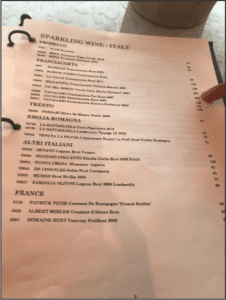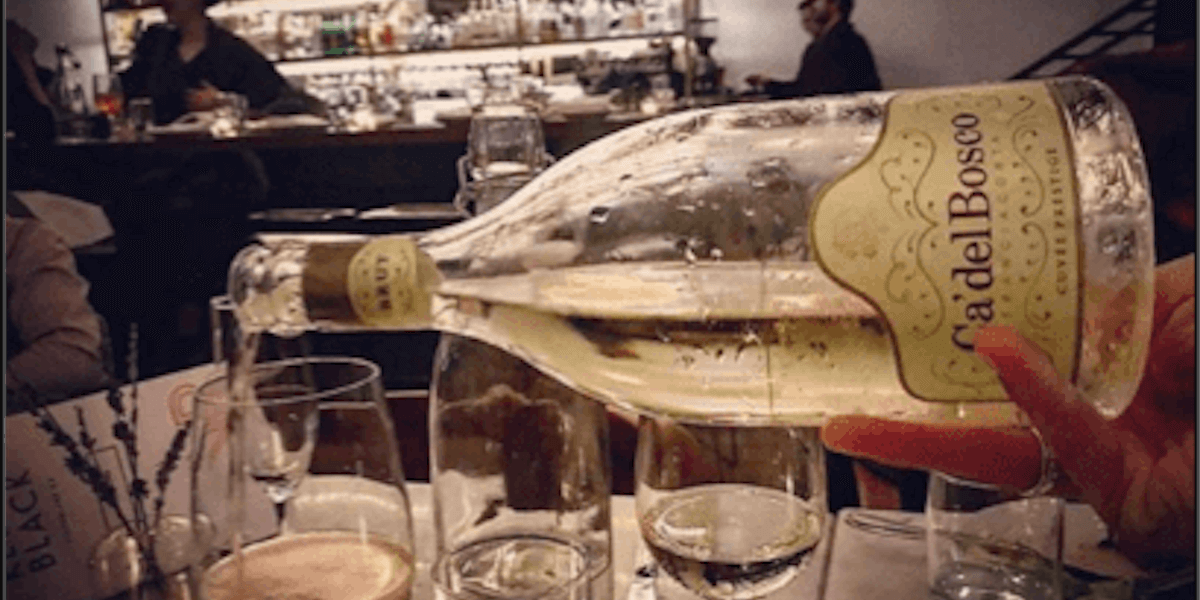by Kristina Sazama, Wine Educator, Santa Margherita USA
 Our eyes fill with delight when we find a well-curated, sparkling wine list. The standard list will always start with Champagnes, followed by a group that includes the rest of the sparkling wines of the world. But as your guests continue to explore the world through the wines they consume, you would do them a great service by giving Franciacorta wine its own section on your wine list.
Our eyes fill with delight when we find a well-curated, sparkling wine list. The standard list will always start with Champagnes, followed by a group that includes the rest of the sparkling wines of the world. But as your guests continue to explore the world through the wines they consume, you would do them a great service by giving Franciacorta wine its own section on your wine list.
Certainly, many guests and your staff should already be pretty familiar with Champagne, and how the traditional method produces wines of complexity and quality. It only takes one, small step further to introduce a section dedicated to Franciacorta. In fact, increased velocity in sales often results when Franciacorta wine is given its own section on a wine list, as this invites a dialogue between guests and staff. The single word, “Franciacorta”, identifies the region, the production method, and the wine itself, and these wines are full of stories to share. Your staff and consumers alike will revel and take pleasure in their new ‘discovery’!
Distinctive Style
Consistency and quality are the hallmarks of Franciacorta. While the wines are made with some of the same grapes as Champagne, Franciacorta production rules allow for the inclusion of Pinot Bianco and Erbamat. Indigenous to the region, the late-ripening, high acid Erbamat grape is unique lens for your guests to explore the exceptional terroir of Franciacorta.
The Franciacorta region is also a bit warmer than Champagne, resulting in wines with more balanced fruit aromas and minerality than the more typically leaner Champagne. It is for this same reason of balance that Franciacorta can have a much lower dosage than is often found in Champagne: 2 to 6 g/L for Franciacorta wine versus 9 to 12 g/L for typical Champagne. This lower dosage means Franciacorta is more reflective of the terroir of the region, and guests will be sure to excite in discovering the many varietals.
Ultimately, Franciacorta wine is a different style of wine than Champagne. One is not necessarily better than the other but allowing Franciacorta to be listed in its own heading will create goodwill with your guests as you allow them to discover their own preference.
Higher Production Standards
With the strictest production standards for sparkling wines in Europe, Franciacorta stands alone within its category. Franciacorta wine is allowed a yield of up to 12 tons of grapes per hectare, compared with up to 15 tons everywhere else. After that, only 54% of the juice can be pressed off, among the smallest amount allowed in Europe. Finally, Franciacorta has the longest ageing laws for traditional method sparkling wine. All of this contributes to the high-quality of the wine that is produced and sold to your guests.
| Yields per hectare | ||||
|
Grapes |
Finished wine |
Bottles per ha |
Minimum Period on the lees |
|
| Franciacorta | Variable up to 12 tons | 54% | 8,666 | Franciacorta: 18 months
Satèn and Rosé: 24 months Vintage: 30 months Riserva: 60 months |
| Champagne | Variable up to 15.5 tons | 64% | 8,840-13,175 | NV: 15 months
Vintage: 36 months |
| Cava | < 12 tons | 66% | 10,560 | Cava DO: 9 months
Reserva: 15 months Gran Reserva: 30 months |
Already a Classic
So distinctive is Franciacorta, that, similar to Champagne, it is one of the few wines in Europe that is not required to state the PDO level on the label (in the case of Franciacorta, it would be DOCG). Further, it is strictly prohibited for a bottle of Franciacorta to use the phrase vino spumanteon its label, the same way you don’t find the phrase vin mousseuxon Champagne. The name captures it all. The European Union has legislated that Franciacorta wine is so unique, that the name Franciacorta alone is enough to identify the wine’s style, its place of origin and elevated level of quality. And really, since it is not an obligation to say vino spumanteon the bottle, it seems illogical to list Franciacorta under “sparkling wines”.
Despite being a classic wine, the production levels in Franciacorta are small when compared to Champagne (under 18 million bottles versus 300 million in Champagne, annually), so listing your Franciacorta separately will easily satisfy your guests’ eagerness to experience the highest-quality wines.
Franciacorta Should Have Its Own Category
As Franciacorta stands alone as a high-quality producer of wine, it only makes sense to list these wines in their own category. With its own distinct style, the highest production standards, and a more exclusive offering, guests will take pleasure in finding themselves navigating your list to this new discovery when you properly put Franciacorta wine as its own listing.







